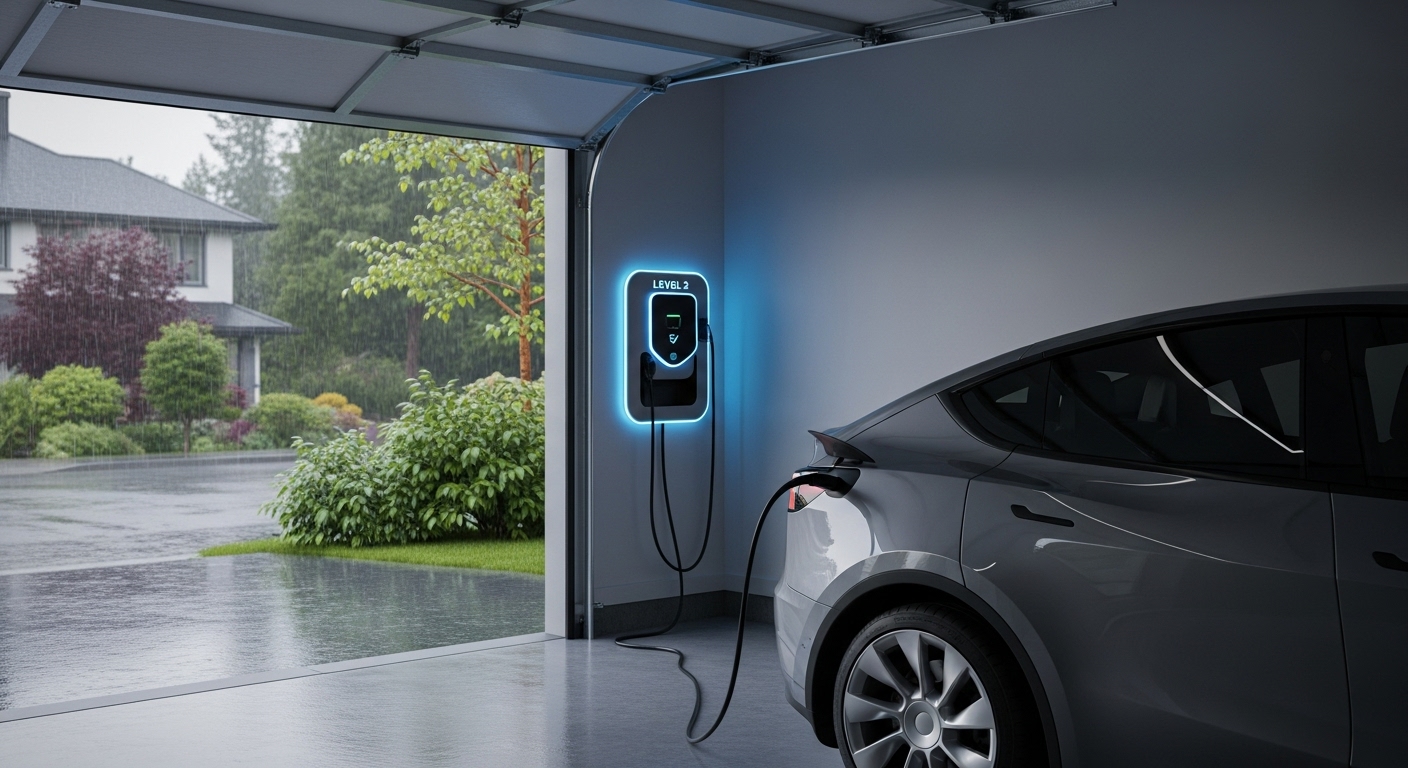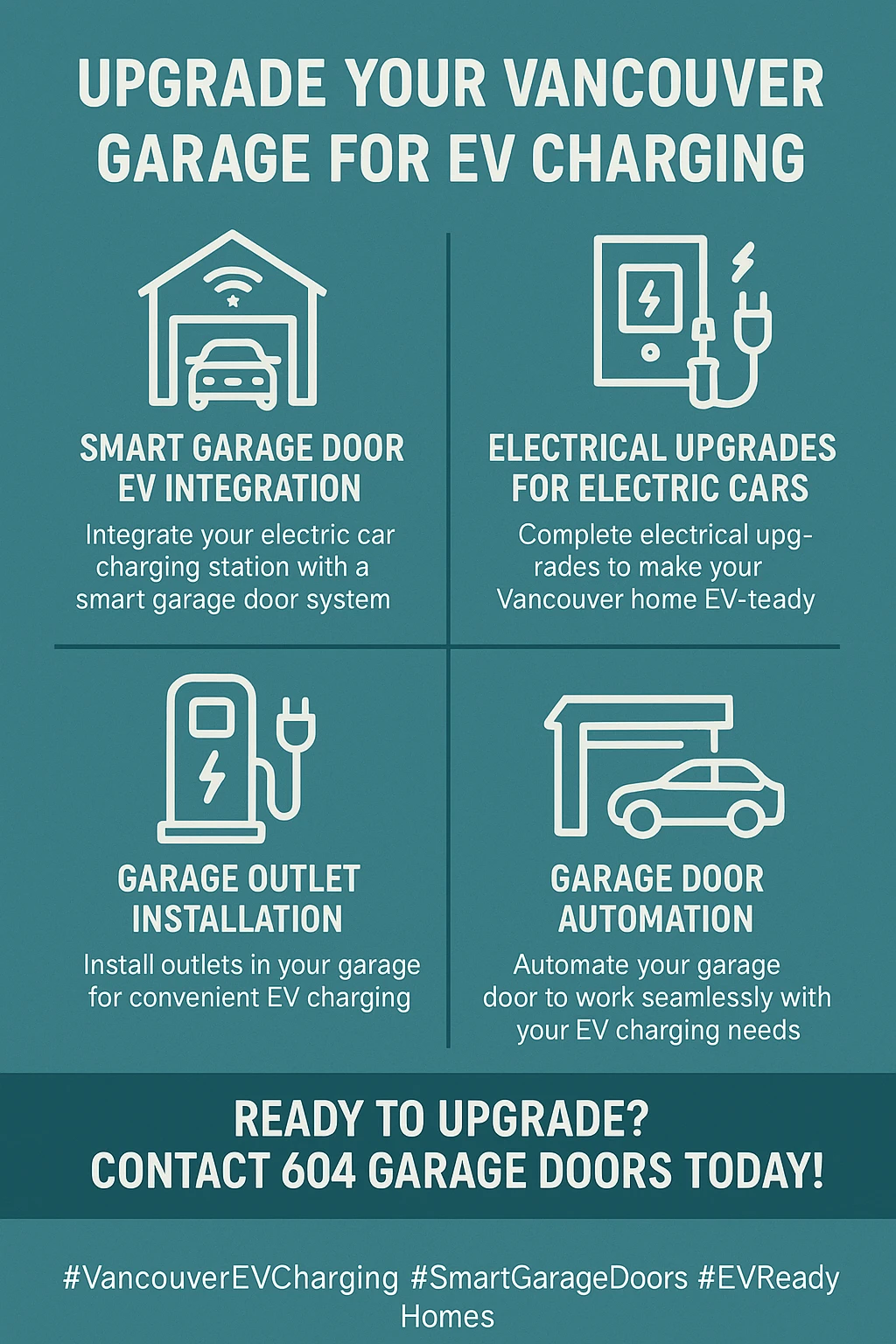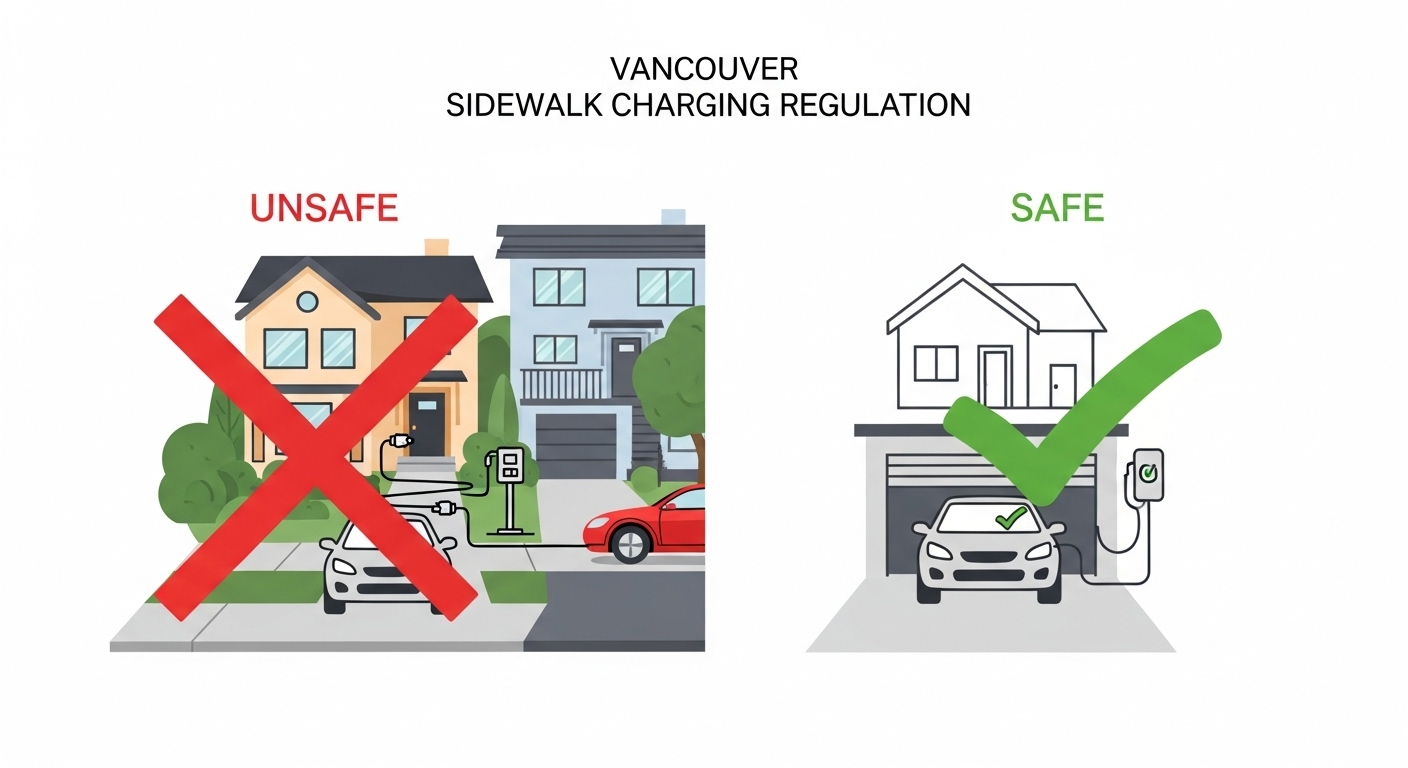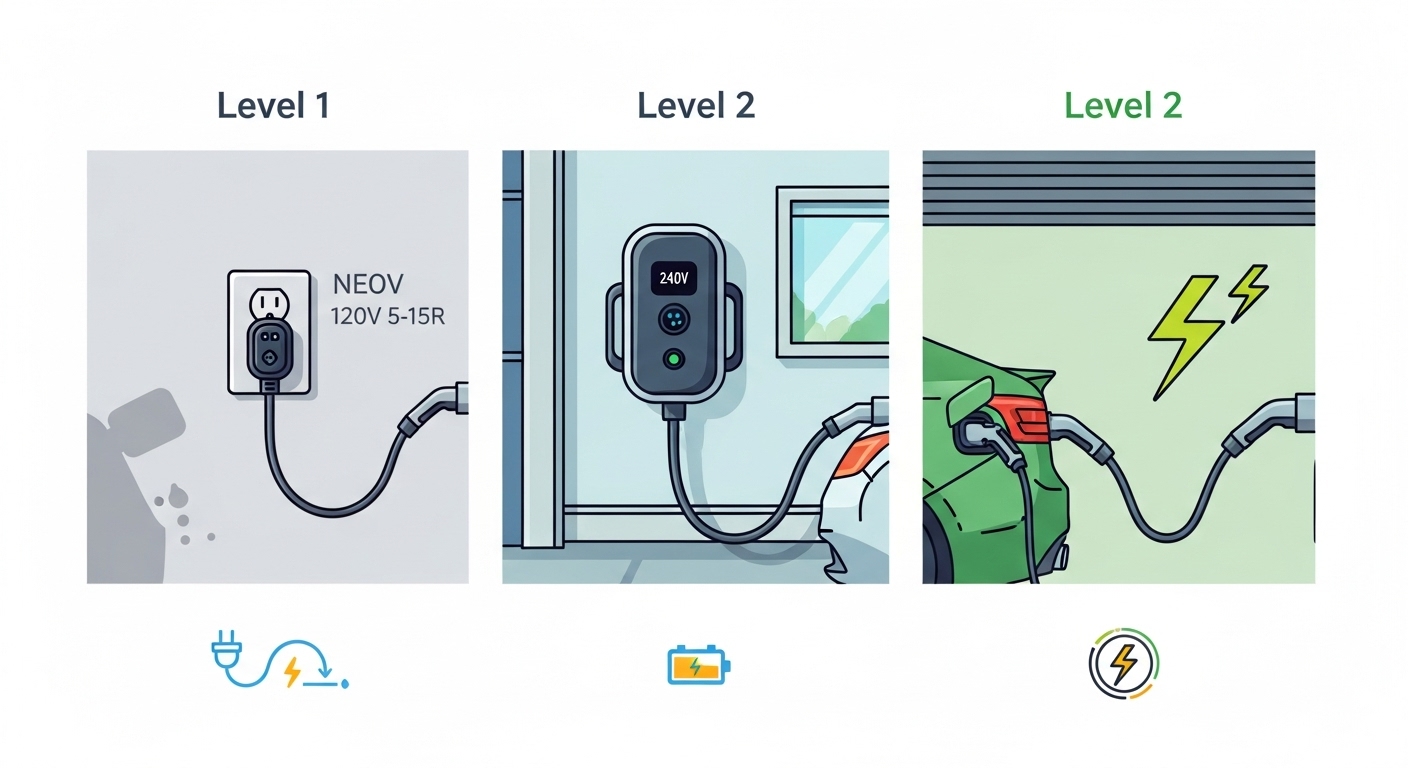Ready to turn your Vancouver garage into an EV-charging powerhouse but not sure where to start with integrating garage door upgrades and charging infrastructure? We’ll walk through everything from smart garage door automation to electrical panel upgrades, helping you create a seamless charging experience that adds serious value to your home.
Picture this: you pull into your driveway after a long day, and your garage door automatically opens as your Tesla recognizes home. Your car glides into the garage, you plug in your charging cable, and the door closes behind you—all while your Level 2 charger begins pumping electrons into your battery at lightning speed compared to that old 120V outlet. This isn’t some far-off fantasy; it’s exactly what thousands of Vancouver homeowners are creating right now by thoughtfully upgrading their garage infrastructure for electric vehicle integration. The intersection of smart garage technology and EV charging represents one of the most practical and valuable home improvements you can make, especially as Vancouver continues leading North America in electric vehicle adoption.

Vancouver homeowners face unique considerations that don’t exist in other cities, particularly around municipal regulations that actually prohibit Level 2 charging cables from crossing city sidewalks. This means your garage isn’t just a nice-to-have for EV charging—it’s often your only legal option for faster charging speeds. The City of Vancouver has established comprehensive licensing requirements for EV charging infrastructure, and understanding these regulations shapes every decision about how you configure your charging setup. Beyond regulatory compliance, Vancouver’s maritime climate creates specific technical requirements around moisture protection, corrosion resistance, and electrical safety that influence equipment selection and installation approaches.
The technology landscape has evolved dramatically over the past few years, with smart chargers now offering Wi-Fi connectivity, mobile app control, load management capabilities, and seamless integration with vehicle systems. When you combine these advanced chargers with automated garage door systems, intelligent lighting, and proper electrical infrastructure, you create a genuinely integrated smart garage environment that transforms your daily routine. However, achieving this integration requires navigating complex decisions around electrical capacity, charger selection, garage door compatibility, permitting requirements, and installation sequencing—all while maximizing available rebates that can offset hundreds of dollars in costs.
Key Takeaways
- Vancouver prohibits Level 2 charging cables from crossing city sidewalks, making garage-based charging installations essential for faster charging speeds and regulatory compliance
- BC Hydro and CleanBC rebates provide up to $350 toward Level 2 charger installation costs, significantly reducing the typical $800-$2,500 total investment
- Most homes require electrical panel assessment and potentially dedicated circuit installation before Level 2 charger installation, as EV chargers draw 24-42 amps during operation
- Smart garage door systems like myQ can integrate directly with Tesla and other vehicles, providing automatic door operation as you arrive and depart
- Professional installation by licensed electricians ensures code compliance, passes municipal inspections, and maintains homeowner insurance coverage

Understanding Vancouver’s EV Charging Regulatory Framework
Vancouver has positioned itself as a pioneering municipality in electric vehicle infrastructure policy, establishing regulatory frameworks that directly impact how homeowners approach garage door and EV charging integration. The city introduced a comprehensive licensing system for electric vehicle owners who wish to place charging cords across city sidewalks, creating specific guidelines about what charging infrastructure configurations are legally permissible in residential settings. This regulatory approach reflects Vancouver’s broader commitment to EV adoption, as evidenced by the city becoming the first municipality in North America to require 240-volt electric vehicle charging circuits in new homes and multi-unit residential buildings. Understanding these regulatory requirements becomes essential for homeowners planning any garage modifications related to EV charging infrastructure.
The Vancouver licensing policy creates important distinctions between different charging levels and establishes strict requirements about cable placement and usage patterns. Level 1 charging cords are permitted to cross city sidewalks when properly licensed, but Level 2 EV charging cords are explicitly prohibited from crossing city rights-of-way or sidewalks under current municipal regulations. This regulation means that homeowners without garage or driveway access who have installed Level 2 chargers cannot legally use them for charging vehicles visible from the street, fundamentally making garage door integration a necessary compliance component rather than merely a convenience feature. The city’s climate emergency plan, approved in recent years, included several initiatives to increase access to EV charging infrastructure, establishing regulatory context for why garage-integrated solutions represent critical infrastructure upgrades for Vancouver residents.

The transportation framework established through Vancouver’s long-term planning emphasized encouraging EV use and providing adequate charging infrastructure, creating a regulatory environment that actively supports homeowner investments in garage-based charging solutions. Property owners seeking to install or upgrade their charging infrastructure should understand that Vancouver requires proof of personal liability insurance of at least one million dollars and at least five hundred thousand dollars in automobile liability insurance if they install chargers that cross public rights-of-way. These requirements underscore that Vancouver treats EV charging infrastructure as serious infrastructure requiring professional installation and appropriate risk management protocols. For most homeowners, these regulatory complexities argue strongly for garage-based installations that avoid public right-of-way complications entirely.
Additionally, Vancouver’s building permit requirements for electrical work create additional layers of regulatory compliance that homeowners must navigate successfully. The city requires electrical permits for new circuits, professional installation by licensed electricians for hardwired chargers, and municipal inspections before systems become operational. Working with contractors familiar with Vancouver’s specific requirements, local electrical codes, and inspection procedures streamlines the approval process considerably while ensuring first-pass inspection success. The regulatory framework ultimately encourages garage-based installations through a combination of incentives for private property installations and restrictions on public right-of-way usage, making garage integration both practically and legally advantageous.
Three Levels of EV Charging and Their Garage Requirements
Understanding the three distinct levels of EV charging technology provides the foundation for determining what garage door and electrical upgrades are necessary for your specific charging needs and usage patterns. Level 1 charging represents the most basic option, utilizing standard 120-volt household outlets that most homes already possess, typically providing 2 to 5 miles of driving range per hour of charging. According to Vancouver’s municipal guidelines, most people can charge sufficient range for their daily driving needs in under four hours using Level 1 charging, though this assumes relatively modest daily mileage requirements. For homeowners with established daily commutes of twenty to thirty miles, Level 1 charging may provide adequate functionality if they maintain consistent overnight charging patterns, though this represents the minimum viable solution for practical EV ownership.

Level 2 charging requires a 240-volt outlet, similar to the electrical requirements for clothes dryers or electric stoves, and must be installed by a licensed electrician with appropriate municipal permits. The performance advantage of Level 2 charging over Level 1 is substantial and transformative—most people can charge sufficient range for daily driving needs in approximately 45 minutes using a Level 2 charger, with typical charging speeds providing 10 to 40 miles of range per hour depending on the specific charger specifications and vehicle compatibility. This dramatic speed improvement over Level 1 makes Level 2 charging the preferred choice for most residential installations, as it aligns perfectly with typical overnight charging patterns while providing weekday rapid charging capability when needed. However, the installation complexity of Level 2 chargers demands careful consideration of garage electrical infrastructure, potentially requiring panel upgrades, new dedicated circuits, and comprehensive professional electrical work.
Level 3 charging, commonly referred to as DC fast charging or supercharging, represents the fastest charging option available and can add nearly 140 miles of range to a battery in just 30 minutes under optimal conditions. However, Level 3 chargers are not suitable for home installation because they require industrial-grade power infrastructure typically associated exclusively with large commercial installations. These systems necessitate detailed business plans, engineering studies, and professional construction companies, making them entirely impractical for residential garage environments due to power requirements that exceed typical residential electrical service capacity. Understanding this hierarchy of charging options becomes crucial because it frames the garage upgrade decision: nearly all residential installations will involve either maintaining basic Level 1 charging or upgrading to Level 2 charging, with Level 2 representing the optimal balance between charging speed and residential electrical feasibility.
The practical implications of this charging hierarchy directly influence garage planning and electrical infrastructure requirements. Level 1 charging imposes minimal electrical demands and requires no garage modifications, but severely constrains flexibility and convenience for most driving patterns. Level 2 charging demands significant electrical infrastructure investment but transforms the EV ownership experience by enabling overnight charging that meets virtually all daily driving needs. For homeowners planning to keep their vehicle for five to ten years or longer, Level 2 installation represents excellent long-term value despite the substantial upfront investment, as the per-charge


